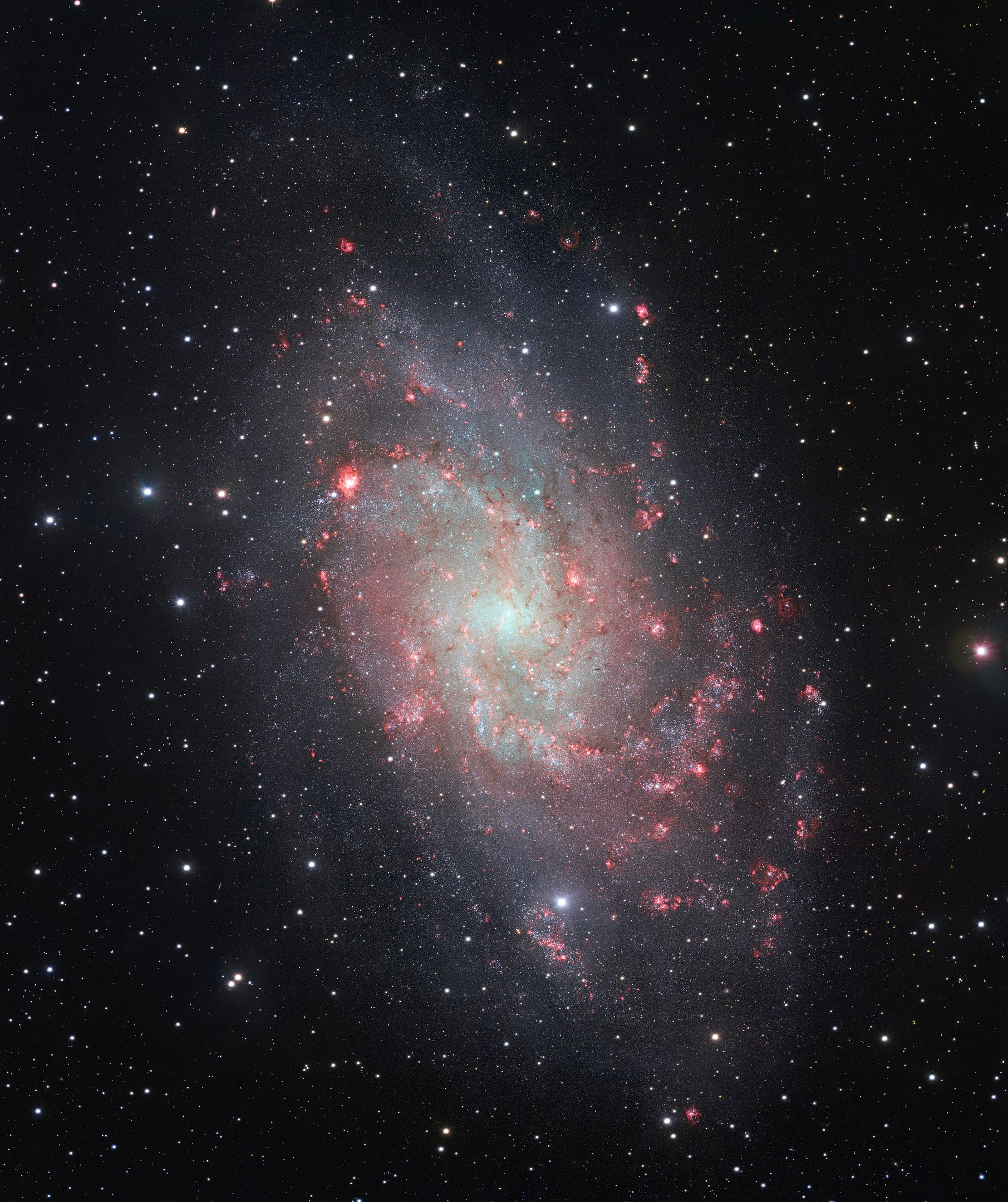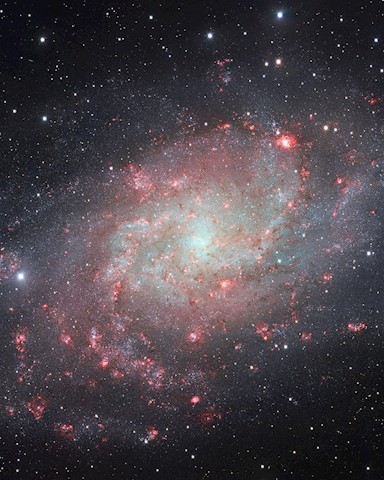The most distant object in the sky that can be watched by the naked eye is the Triangulum Galaxy in the constellation Triangulum. It's heading towards us at high speed: 100,000 km/h (i.e.: 100 times faster than a jet airplane). But don't worry, it'll be 6 billion years before it's here. And by the way, the Milky Way and the Andromeda Galaxy have collided with each other long before that.

The M33 triangle galaxy is the third largest (out of more than 50) galaxies in the Local Group of galaxies; Only the Andromeda Galaxy and the Milky Way are larger. The M33 is located at a distance of 3.2 million light-years and is heading towards us at high speed. It is usually cited as the most distant object that can be seen from Earth with the naked eye. Photo: ESO.
The Milky Way (our own galaxy), the Andromeda Galaxy and the Triangulum Galaxy are the three largest galaxies in the Local Group of galaxies (which consists of some 50+ galaxies). Our fates have long been intertwined, astronomers expect the Milky Way and the Andromeda Galaxy begin their collision in around four billion years, having developed into a new, elliptical galaxy after another couple of billion years.
Exactly how the Triangle Galaxy will behave is not known, but with data from the Hubble Space Telescope and ESA's Gaia Telescope, astronomers believe the Triangulum Galaxy may already be in a kind of orbit around the Andromeda Galaxy. Perhaps it will eventually collide with the new Milky Way-Andromeda Galaxy? Whoever lives will see.
Can be watched by the naked eye
The Triangulum Galaxy is the third largest galaxy in the Local Group and is very well located in the northern sky. During February you will find it in the west, halfway (40°) up in the sky at 20:00 in the evening (see map further down the page).
If you have young eyes and are in a place beyond the city lights, on a clear night you can see the Triangulum Galaxy to the naked eye! This makes it the most distant, permanent object that can be seen with the naked eye from Earth. The magnitude is 5.7 and in the sky it has an extent of about 1.2° * 0.7°. (The moon is about 0.5° in diameter, so there you get an idea of the size on the sky. ) It is brighter in the middle, so to the naked eye it does not appear as large as the moon in its distribution – only the inner parts can be seen with the naked eye.
The galaxy was first observed in the mid-17th century and was “rediscovered” by Charles Messier in 1764, whereupon he gave it the order number 33 in his catalogue of "non-comets". Consequently, we call it M33 today and that is how it is found in the amateur telescope software.
The Triangulum galaxy in a pair of binoculars
The Triangulum galaxy can easily be seen in a regular pair of binoculars if the conditions are good. As with most deep sky objects, a dark night sky, free of disturbing lights and haze in the air is required. If the sky is "blurry" in itself, the objects disappear in the haze. The larger the binoculars and the higher the magnification, the more you can see of this spiral galaxy.
The galaxy is so far away that individual stars cannot be distinguished. In a pair of binoculars, you will see a small misty spot; perhaps a little "spiky" where the tags suggest the galaxy arms extending out from the core. But not bad; You've seen the invisible and something 99.99% of the world's people will never see: a vast galaxy, 60,000 light-years in diameter with around 40 billion stars. And it's coming towards us at breakneck speed!
The Triangulum Galaxy in a Telescope
Already in a beginner's telescope – e.g. a Celestron Astromaster 130 EQ – with a good eyepiece that provides about 100 times magnification, the galaxy arms can be hinted at. But just like for the naked eye and with a pair of binoculars, a dark night sky without city lights is required.
As an amateur astronomer, you know that even with the largest telescope, you can't see the details reproduced in a photograph. A camera can collect light for several hours to get details in galaxies and nebulae. Your eye – however big it may be made with a mirror or lens – can only collect light a fraction of a second.
To get an idea of what an eye can see with a smaller telescope, there are those who draw what they see in their telescope. In the following link you can just see how an experienced amateur astronomer has drawn what the Triangle Galaxy looks like, just in a 130mm Newton telescope: Drawing the Triangulum Galaxy visually from a 130mm telescope.

The M33 Triangulum galaxy is high above the horizon at 8 p.m. To find M33, start from the star Mirach in the constellation Andromeda. In a pair of binoculars with a large field of view, you can see M33 on the far left of the field of view, with Mirach on the right. Map: Stellarium
Finding the Triangulum Galaxy in the Night Sky in February
The M33 Triangulum galaxy is high above the horizon (40 degrees) in February at 8 p.m. in northern Europe. On a starry night, beyond disturbing light, it can be seen to the naked eye. The easiest way to "star jump" your way to the M33 is to start from the bright (double) star Mirach in the constellation andromeda (see map). At 20:00 in the evening, aim for a point 7 degrees to the left of Mirach you will find it. In a handkerchien with a large field of view, you can see Mirach on the far left of the field of view, with Mirach on the right.
If you have a computerized telescope, just choose the Messier-button and enter “33” and click “Go” and the telescope will find the galaxy for you.
Text: Claes Tunälv
